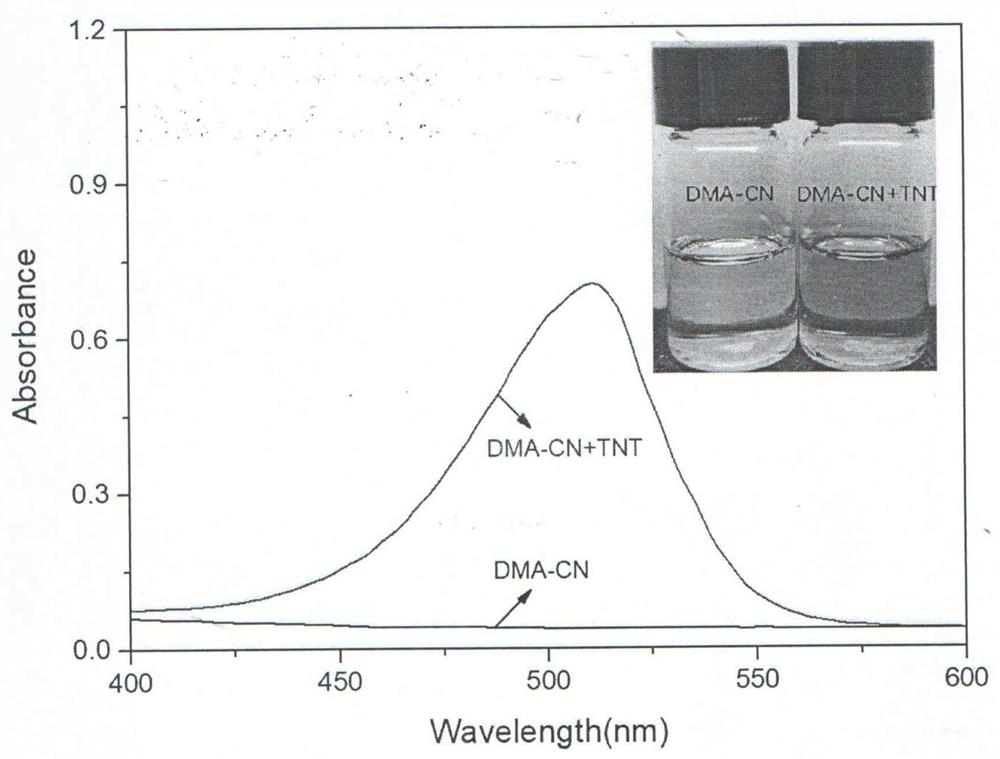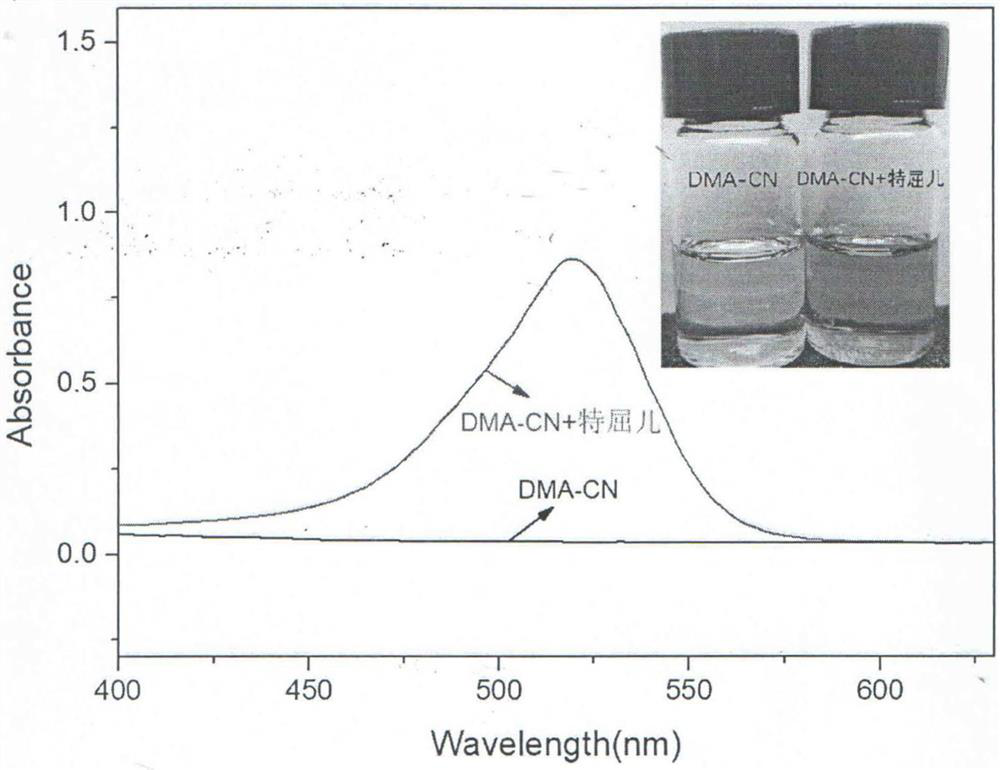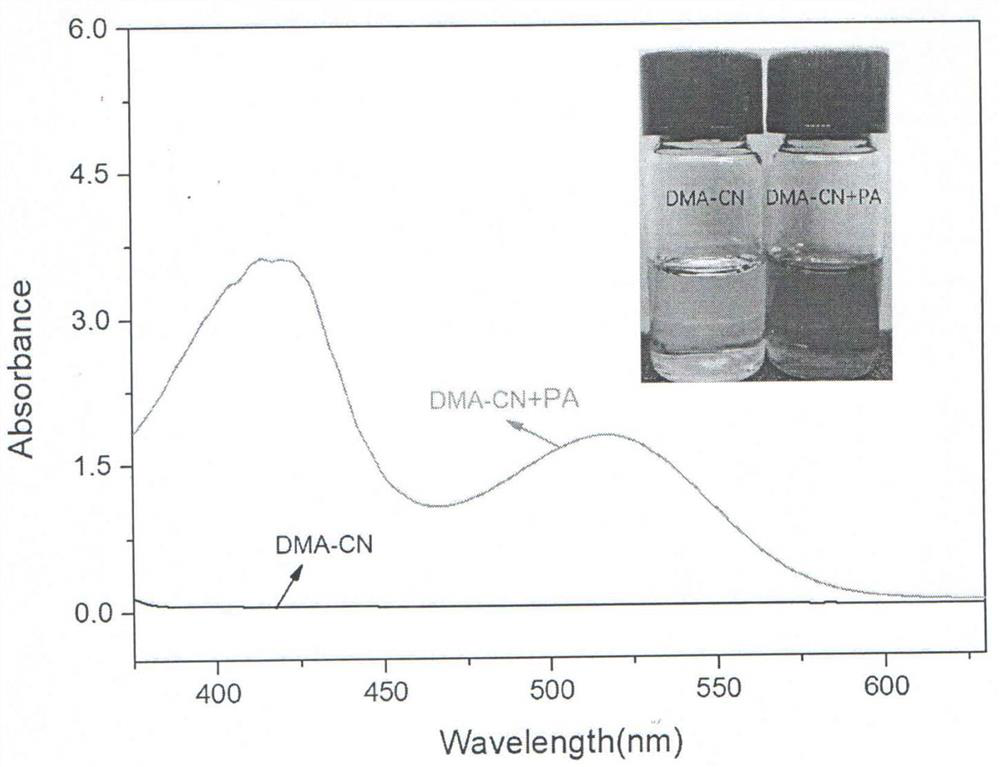Reagent for rapidly detecting trinitrotoluene, tetront, picric acid, dinitrotoluene and sulfur in explosives
A technology of trinitrotoluene and dinitrotoluene, applied in the direction of color/spectral characteristic measurement, etc., can solve the problems of cumbersome operation procedures, complex and frequent components, and achieve the effects of convenient popularization and application, high detection efficiency and cost saving
- Summary
- Abstract
- Description
- Claims
- Application Information
AI Technical Summary
Problems solved by technology
Method used
Image
Examples
Embodiment 1
[0034] a. At room temperature, the organic probe (E) 2-(3-cyano-4-(4-(dimethylamino)styryl)-5,5-dimethylfuran-2(5H)- Subunit) malononitrile 10mg was dissolved in 50mL of N,N-dimethylformamide as a solvent to prepare a probe solution with a concentration of 0.2μg / μL;
[0035] b. The probe solution obtained in step a is added to the reducing agent as sodium borohydride 100mg, and ultrasonication is carried out for 5min to obtain the rapid detection of explosives trinitrotoluene, tetrahydrol, picric acid, dinitrotoluene and sulfur free colored detection reagents.
[0036] Measure 3 mL of the detection reagent into a quartz cuvette, add 20 μL of the prepared 10 mM trinitrotoluene (TNT) standard solution, and perform UV-visible absorption spectrum scanning with a UV-Vis spectrophotometer. Trinitrotoluene (TNT) ) before and after the addition of the spectrum as shown in figure 1 As shown, by comparing the spectra before and after the reaction, it can be seen that there is an obvio...
Embodiment 2
[0038] a. At room temperature, the organic probe (E) 2-(3-cyano-4-(4-(dimethylamino)styryl)-5,5-dimethylfuran-2(5H)- Subgroup) malononitrile 5mg was dissolved in 500mL of dimethyl sulfoxide, and prepared into a probe solution with a concentration of 0.01μg / μL;
[0039] b. The probe solution obtained in step a is added to the reducing agent as potassium borohydride 30mg, ultrasonicated, and the time is 10min, to obtain the rapid detection of explosives trinitrotoluene, tetrahydrol, picric acid, dinitrotoluene and sulfur free colored reagents.
[0040] Measure 3 mL of detection reagent into a quartz cuvette, then add 20 μL of the prepared 10 mM Tetrier standard solution, and scan the UV-Vis absorption spectrum with a UV-Vis spectrophotometer. figure 2 As shown, by comparing the spectra before and after the reaction, it can be seen that there is an obvious absorption peak at 520 nm after the reaction, and the reagents before and after the reaction are directly photographed (suc...
Embodiment 3
[0042] a. At room temperature, the organic probe (E) 2-(3-cyano-4-(4-(dimethylamino)styryl)-5,5-dimethylfuran-2(5H)- Subunit) malononitrile 5mg was dissolved in 50mL of N,N-dimethylformamide as a solvent to prepare a probe solution with a concentration of 0.1μg / μL;
[0043] b, adding the probe solution obtained in step a to the reducing agent as sodium borohydride 60mg, ultrasonication, and the time is 15min, to obtain the rapid detection of explosives trinitrotoluene, tetrahydrol, picric acid, dinitrotoluene and sulfur free colored reagents.
[0044] Measure 3mL of the detection reagent into a quartz cuvette, add 20μL of the prepared 8mM picric acid standard solution, and scan the UV-Vis absorption spectrum with a UV-Vis spectrophotometer. The spectra before and after the addition of picric acid are as follows: image 3 By comparing the spectra before and after the reaction, it can be seen that two obvious absorption peaks appeared at 420 nm and 517 nm after the reaction, an...
PUM
 Login to View More
Login to View More Abstract
Description
Claims
Application Information
 Login to View More
Login to View More - R&D
- Intellectual Property
- Life Sciences
- Materials
- Tech Scout
- Unparalleled Data Quality
- Higher Quality Content
- 60% Fewer Hallucinations
Browse by: Latest US Patents, China's latest patents, Technical Efficacy Thesaurus, Application Domain, Technology Topic, Popular Technical Reports.
© 2025 PatSnap. All rights reserved.Legal|Privacy policy|Modern Slavery Act Transparency Statement|Sitemap|About US| Contact US: help@patsnap.com



